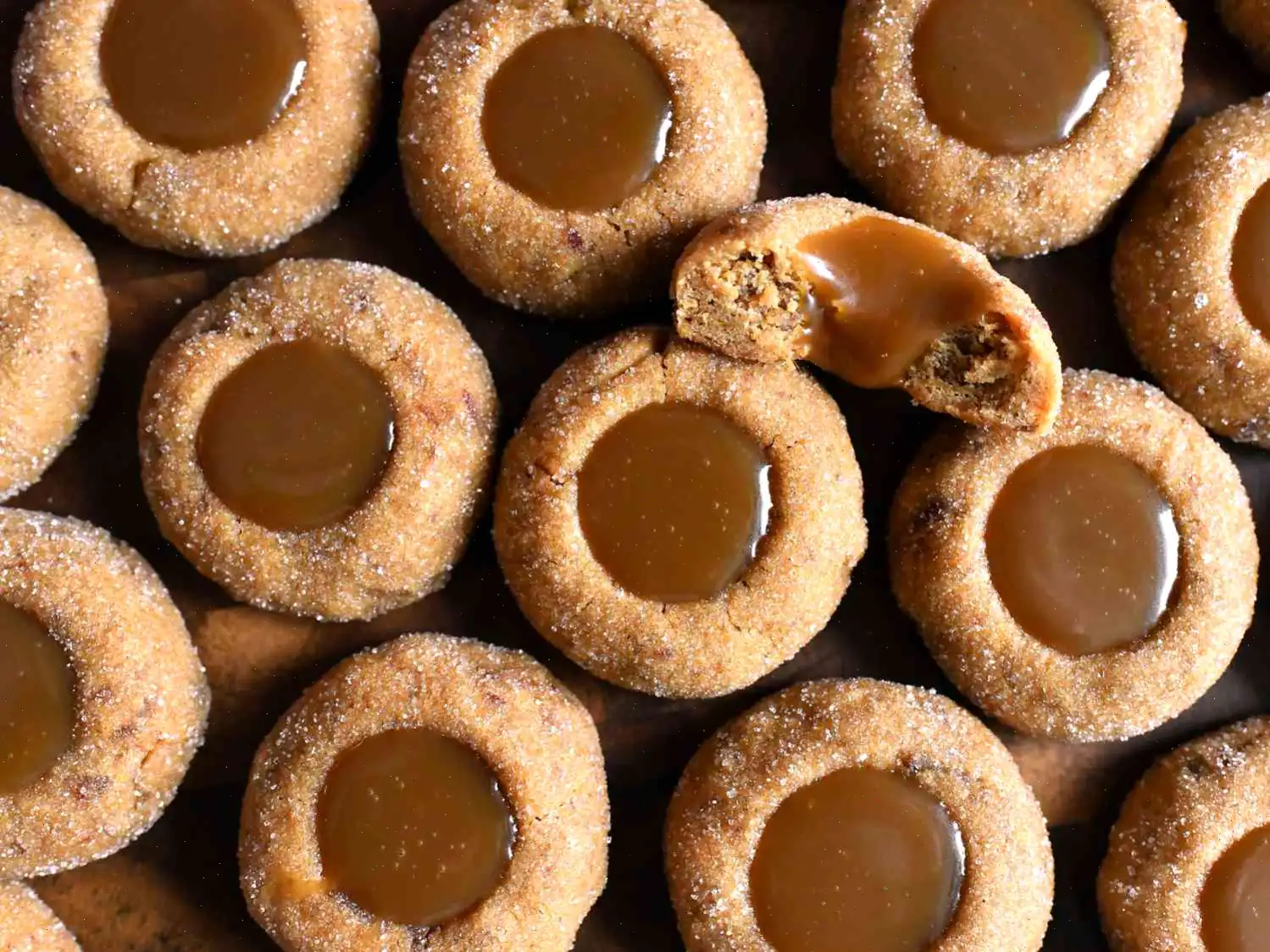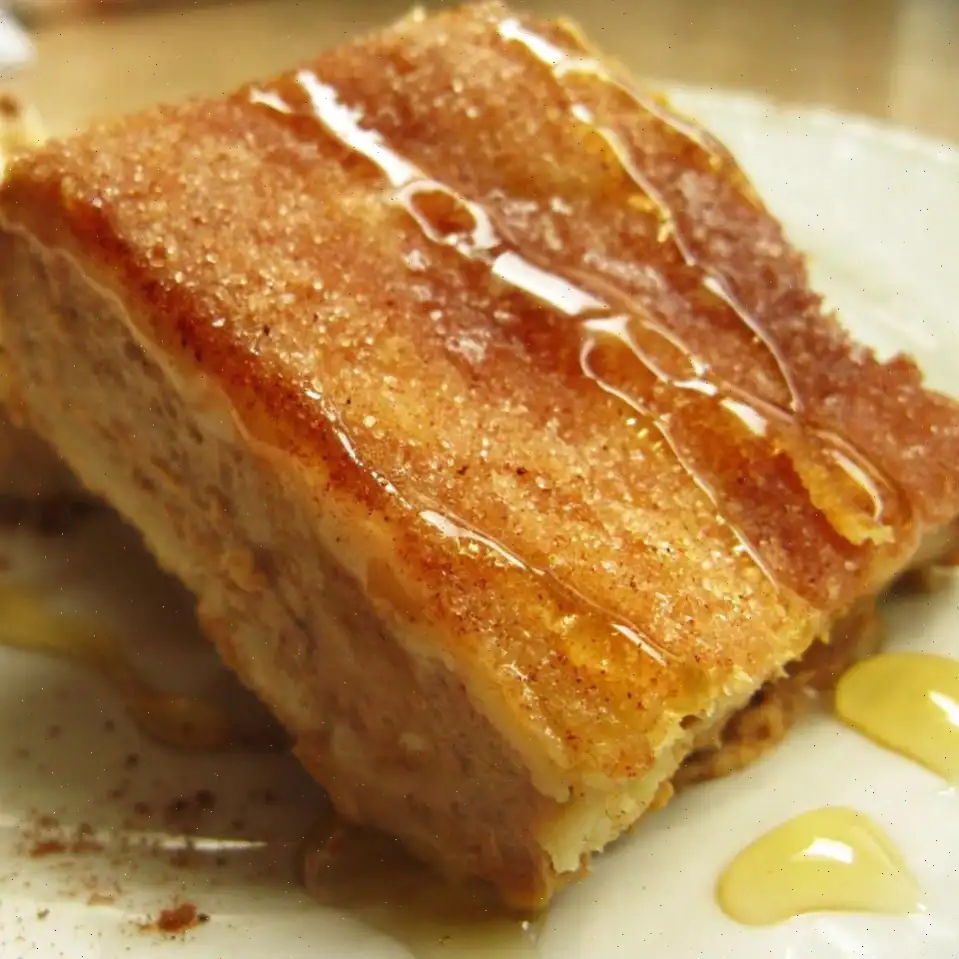
Sticky Toffee Pudding Thumbprints Recipe
Ingredients
For the Cookie Dough:
- 12 ounces pitted dried Medjool dates
- Boiling water, as needed
- 1 teaspoon baking soda
- 1 cup unsalted butter
- 1 cup firmly packed dark brown sugar
- 1 tablespoon unsulphured molasses
- 1 tablespoon vanilla extract
- 2 teaspoons instant espresso powder
- 3/4 teaspoon salt
- 1/4 teaspoon ground nutmeg
- 1/8 teaspoon ground cloves
- 1/8 teaspoon ground allspice
- 1 large egg, at room temperature
- 2 1/2 cups all-purpose flour
- 2 teaspoons cornstarch
- 1 teaspoon baking powder
- 1/2 cup white sugar, or as needed
For the Toffee Sauce:
- 1/4 cup unsalted butter
- 2 tablespoons water
- 1/2 tablespoon unsulphured molasses
- 1/4 teaspoon salt
- 2/3 cup heavy cream
- 2 teaspoons vanilla extract
- 1 teaspoon lemon juice
Directions
Step 1:
Place dates in a small heatproof bowl. Pour in enough boiling water to cover the dates, then stir in baking soda. Let the dates soak for 10 minutes.
Step 2:
While the dates are soaking, place 1 cup of butter in a light-colored saucepan over medium-low heat. Stir constantly until the butter turns golden brown, which should take about 5 to 10 minutes. Once browned, pour the butter into a large mixing bowl and let it cool for 10 minutes.
Step 3:
Drain the dates and transfer them to a food processor or blender. Pulse until the mixture becomes a thick paste with only a few large chunks of date remaining.
Step 4:
To the cooled browned butter, add the brown sugar, molasses, vanilla extract, espresso powder, salt, nutmeg, cloves, and allspice. Stir everything together until fully combined.
Step 5:
Crack the egg into the mixture and stir for about 1 minute until well incorporated. Then, add the date paste and mix until completely combined.
Step 6:
Gradually add 1 1/2 cups of flour, cornstarch, and baking powder to the mixture. Stir until just combined. Then add the remaining 1 cup of flour, mixing until incorporated.
Step 7:
Pour the 1/2 cup of white sugar into a small bowl. Take 1 tablespoon of dough and roll it into a ball. Roll the ball in the sugar until its fully coated. The dough will be soft but should still hold its shape.
Step 8:
Using your thumb or the handle of a spoon or spatula, create an indentation about 1/2-inch wide in the center of each ball. Place the cookies on a plate. Repeat with the remaining dough.
Step 9:
Refrigerate the cookies for at least 30 minutes to chill.
Step 10:
Preheat the oven to 350F (180C). Line baking sheets with silicone mats or parchment paper. Arrange the chilled cookies 1 inch apart on the baking sheets.
Step 11:
Bake the cookies for 12 to 14 minutes, or until they begin to puff and small cracks form on the surface. Remove from the oven and immediately press the centers down using a spoon handle or spatula.
Step 12:
Let the cookies cool on the baking sheet for 5 minutes, then transfer them to a wire rack to cool completely.
For the Toffee Sauce:
Step 13:
In a heavy-bottomed saucepan, combine the brown sugar, butter, water, molasses, and salt. Cook over medium-low heat, stirring constantly, until the mixture reaches a boil. Reduce the heat to low and simmer for 2 minutes while stirring continuously.
Step 14:
Carefully pour in the cream (the mixture will sputter), and continue stirring. Bring it back to a boil and cook for an additional 5 minutes, stirring constantly.
Step 15:
Remove the toffee sauce from the heat, then stir in the vanilla extract and lemon juice. Pour the sauce into a heatproof glass measuring cup with a spout. Allow it to cool and thicken slightly, which should take around 15 to 20 minutes, stirring occasionally.
Step 16:
Once the sauce has thickened, carefully pour it into the center of each cookie, taking care not to overfill. Alternatively, you can spoon the sauce into the cookies instead of pouring it directly from the measuring cup. The toffee sauce will continue to thicken as it cools.
Storage:
Store the cookies in a single layer in an airtight to keep them fresh.
Nutrition Facts (per serving):
- Calories: 152
- Total Fat: 7g (9% Daily Value)
- Saturated Fat: 4g (21% Daily Value)
- Cholesterol: 22mg (7% Daily Value)
- Sodium: 94mg (4% Daily Value)
- Total Carbohydrate: 23g (8% Daily Value)
- Dietary Fiber: 1g (3% Daily Value)
- Total Sugars: 16g
- Protein: 1g (2% Daily Value)
- Calcium: 26mg (2% Daily Value)
- Iron: 1mg (3% Daily Value)
- Potassium: 92mg (2% Daily Value)

Sticky Toffee Pudding Thumbprints is a twist on the classic British dessert, combining the flavors of chewy toffee and rich dates with the fun and familiar texture of a thumbprint cookie. With its origins rooted in the United Kingdom, this delightful treat has become popular worldwide, often found on dessert tables in both home kitchens and restaurants alike. Below, we explore its history, regional variations, and unique features, giving you a full understanding of why its so beloved.
History and Origins
The origins of Sticky Toffee Pudding date back to the 1960s, though the desserts exact creator remains debated. Some credit the dish to the Lake District in Northern England, where it is said to have been served in a local hotel. Others believe it gained popularity in the 1970s, particularly when it was featured on the menu of a prominent British hotel. Traditionally, the pudding is made from a moist sponge cake, rich in dates, and served with a generous helping of toffee sauce. The thumbprint cookie version takes this classic pudding and condenses it into a small, bite-sized form, perfect for individual servings.
Regional Variations
Sticky Toffee Pudding is a versatile dessert, with many regional variations in the UK. In some areas, the pudding is made with dark brown sugar or golden syrup to give it a more complex flavor. The thumbprint cookie version, however, adds a unique twist, with the traditional toffee sauce filling the center of each cookie, allowing for easy sharing and a portable version of the beloved dessert. The addition of espresso powder in the cookie dough offers a subtle coffee flavor that enhances the richness of the toffee, providing a depth of flavor not found in the original pudding.
Distinguishing Features
While Sticky Toffee Pudding and thumbprint cookies may seem similar, their key differences lie in both form and texture. The classic Sticky Toffee Pudding is a moist, spongy cake drenched in warm toffee sauce, typically served as a rich dessert at formal dinners. The thumbprint variation, on the other hand, is a cookie-based version that offers a chewy yet crumbly texture, with a sweet toffee filling in the center. This makes the thumbprint cookies more portable and easier to serve in smaller portions, making them a hit at casual gatherings or as a festive treat during the holidays.
Where is it Typically Served?
Sticky Toffee Pudding Thumbprints are often served in British restaurants, particularly those that focus on traditional comfort foods. However, their smaller, bite-sized nature makes them a popular choice for parties, tea-time, and potlucks. They can be found in bakeries across the UK and even in cafes that serve modern interpretations of British classics. The thumbprint version is a fun take on the traditional dessert, allowing for individual servings that are just as satisfying as the full-sized pudding. In the United States, it is gaining popularity as a quirky yet indulgent treat for special occasions and holiday gatherings.
Interesting Facts
- Sticky Toffee Pudding is sometimes known as "date pudding" due to the prominent use of dates in the recipe. Dates add both sweetness and moisture to the pudding, which is part of what makes it so rich and satisfying.
- The earliest known recipe for Sticky Toffee Pudding dates back to the 1960s, but it quickly became a staple in British dessert menus, especially after being popularized by the Sharrow Bay Hotel in the Lake District.
- In some variations of the pudding, the toffee sauce is poured over the pudding and then baked to create a sticky, caramelized layer that hardens as it cools.
- Sticky Toffee Pudding Thumbprints combine two iconic British food traditionssticky toffee pudding and thumbprint cookies, resulting in a unique fusion of flavors and textures.
Whether youre in the UK or abroad, Sticky Toffee Pudding Thumbprints offer a delightful combination of rich, indulgent flavors in a convenient, easy-to-eat form. Perfect for casual gatherings or as a sweet treat to share with friends and family, these cookies prove that even the most traditional desserts can be reinvented with a little creativity.
You can listen to this recipe in AI audio format. Simply click the play button below to listen to the content in a format that suits you best. It’s a great way to absorb information on the go!







